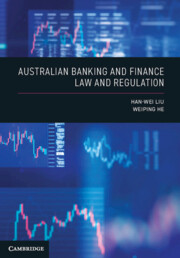1195 results

Australian Banking and Finance Law and Regulation
- Coming soon
-
- Expected online publication date:
- July 2024
- Print publication:
- 31 July 2024
-
- Textbook
- Export citation
Chapter 7 - Using digital technologies to learn with our bodies
-
- Book:
- Supporting Innovative Pedagogies with Digital Technologies
- Print publication:
- 13 June 2024, pp 119-133
-
- Chapter
- Export citation
Chapter 5 - Using digital technologies to learn information knowledge
-
- Book:
- Supporting Innovative Pedagogies with Digital Technologies
- Print publication:
- 13 June 2024, pp 76-97
-
- Chapter
- Export citation
Chapter 2 - The nature of learning and teaching
-
- Book:
- Supporting Innovative Pedagogies with Digital Technologies
- Print publication:
- 13 June 2024, pp 20-33
-
- Chapter
- Export citation
Chapter 12 - Your role as a learner and innovator
-
- Book:
- Supporting Innovative Pedagogies with Digital Technologies
- Print publication:
- 13 June 2024, pp 211-234
-
- Chapter
- Export citation
Chapter 6 - Using digital technologies to learn mental procedures
-
- Book:
- Supporting Innovative Pedagogies with Digital Technologies
- Print publication:
- 13 June 2024, pp 98-118
-
- Chapter
- Export citation
Chapter 8 - Collecting and assessing evidence of learning
-
- Book:
- Supporting Innovative Pedagogies with Digital Technologies
- Print publication:
- 13 June 2024, pp 134-156
-
- Chapter
- Export citation
Chapter 10 - Explore interests via co- and extracurricular activities
-
- Book:
- Supporting Innovative Pedagogies with Digital Technologies
- Print publication:
- 13 June 2024, pp 177-190
-
- Chapter
- Export citation
Chapter 11 - Your role and responsibilities as an educator in a digital world
-
- Book:
- Supporting Innovative Pedagogies with Digital Technologies
- Print publication:
- 13 June 2024, pp 193-210
-
- Chapter
- Export citation
Chapter 1 - Why use digital technologies in learning and teaching?
-
- Book:
- Supporting Innovative Pedagogies with Digital Technologies
- Print publication:
- 13 June 2024, pp 9-19
-
- Chapter
- Export citation
Chapter 4 - Learning and teaching environments
-
- Book:
- Supporting Innovative Pedagogies with Digital Technologies
- Print publication:
- 13 June 2024, pp 61-75
-
- Chapter
- Export citation
Chapter 3 - Models and frameworks for understanding digital technologies in learning environments
-
- Book:
- Supporting Innovative Pedagogies with Digital Technologies
- Print publication:
- 13 June 2024, pp 34-58
-
- Chapter
- Export citation
Chapter 9 - Supporting students’ citizenship and wellbeing in a digital world
-
- Book:
- Supporting Innovative Pedagogies with Digital Technologies
- Print publication:
- 13 June 2024, pp 157-176
-
- Chapter
- Export citation
22 - Sex in Sydney in the Twentieth Century
-
-
- Book:
- The Cambridge World History of Sexualities
- Published online:
- 26 April 2024
- Print publication:
- 16 May 2024, pp 465-486
-
- Chapter
- Export citation
3 - (Un-)Settling Exile
-
-
- Book:
- Mobility and Coercion in an Age of Wars and Revolutions
- Published online:
- 09 May 2024
- Print publication:
- 16 May 2024, pp 58-82
-
- Chapter
-
- You have access
- Open access
- HTML
- Export citation
‘Healthier options tend to get lost in the noise of online’ – Australian shoppers’ experiences with online grocery platforms
-
- Journal:
- Public Health Nutrition / Volume 27 / Issue 1 / 2024
- Published online by Cambridge University Press:
- 14 May 2024, e134
-
- Article
-
- You have access
- Open access
- HTML
- Export citation
Patterns and predictors of low-calorie sweetener consumption during pregnancy: findings from a national survey in Australia
-
- Journal:
- Proceedings of the Nutrition Society / Volume 83 / Issue OCE1 / April 2024
- Published online by Cambridge University Press:
- 07 May 2024, E115
-
- Article
-
- You have access
- Export citation
Estimated intake of vitamin D is low in Aboriginal and Torres Strait Islander people
-
- Journal:
- Proceedings of the Nutrition Society / Volume 83 / Issue OCE1 / April 2024
- Published online by Cambridge University Press:
- 07 May 2024, E147
-
- Article
-
- You have access
- Export citation
2 - Extreme Allies: Australia and the USA
- from Part 2 - Relationships
-
-
- Book:
- Australia in World Affairs 2001–2005
- Published online:
- 04 May 2024, pp 19-44
-
- Chapter
- Export citation
15 - Australian Relations with the Former Communist States of Europe and the Soviet Union
-
-
- Book:
- Australia in World Affairs 1991–1995
- Published online:
- 04 May 2024, pp 181-192
-
- Chapter
- Export citation



